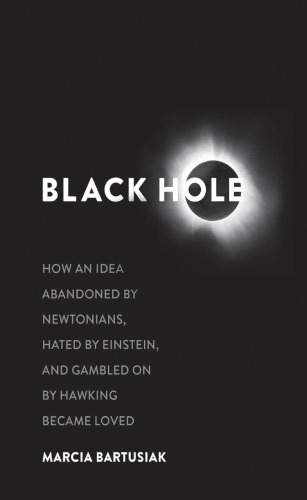
Black Hole
How an Idea Abandoned by Newtonians, Hated by Einstein, and Gambled on by Hawking Became Loved
کتاب های مرتبط
- اطلاعات
- نقد و بررسی
- دیدگاه کاربران
نقد و بررسی

March 30, 2015
Bartusiak (Archives of the Universe), professor in the Graduate Program in Science Writing at MIT, reveals the story and science of black holes in all their “stark and alien weirdness.” Black holes begin, and end, with gravity. The first person to propose this idea was 18th-century English polymath John Michell, who imagined a star so massive that “all light... would be made to return towards it, by its own proper gravity.” As Bartusiak relates, the idea remained a curiosity until Einstein proffered his theory of special relativity (1905) and the idea that gravity could bend light and motion. German astronomer Karl Schwarzschild envisioned an “event horizon,” the point of no return beyond which nothing could escape a massive star’s extreme gravity, but no one believed it could happen. Then Subrahmanyan Chandrasekhar showed how a massive white dwarf star could shrivel to nothing under its own gravity. Bartusiak notes that Einstein and many others rejected the idea, but by the 1960s, observational evidence and computer advances that allowed astronomers to model stellar collapse showed that black holes were real. Bartusiak’s lively, accessible writing and insight into the personalities behind the science make her book an entertaining and informative read.

February 15, 2015
Black holes enthrall physicists and astronomers, as well as Hollywood filmmakers, and readers of this fine popular science account will understand why.It all begins with gravity, writes Bartusiak (Science Writing/MIT; The Day We Found the Universe, 2009) in this entirely engaging narrative of "the cosmic object [astrophysicists are] most likely to be asked about." Although the concept of black holes is ancient, it was Isaac Newton who explained it more or less correctly in 1687. By the 18th century, imaginative scientists realized that since gravity was a universal force, light was not exempt. Gravity from a star far more massive than the sun would slow the light it emitted to zero, and it would become invisible: a black hole. They were right-sort of. In 1916, Einstein's theory of relativity showed that light speed never slows but that gravity distorts space, so light near a large body appears to curve. Examining Einstein's equations, early researchers calculated that as gravity increases, distortion becomes so great that the light would double back. Einstein insisted that no such invisible star existed, and few disagreed until the 1960s, when astronomers detected quasars: strange, distant objects emitting unimaginable quantities of energy equivalent to billions of suns. These turned out to be supermassive black holes; most galaxies have one, ours included. Formerly a mathematical hypothesis, black holes of all sizes became front-page news, occupying brilliant scientists such as Stephen Hawking and John Wheeler, who revealed that they are a normal product of stellar evolution and even more bizarre than predicted. Superior science writing that eschews the usual fulsome biographies of eccentric geniuses, droll anecdotes and breathless prognostication to deliver a persistently fascinating portrait of an odd but routine feature of the cosmos.

























دیدگاه کاربران